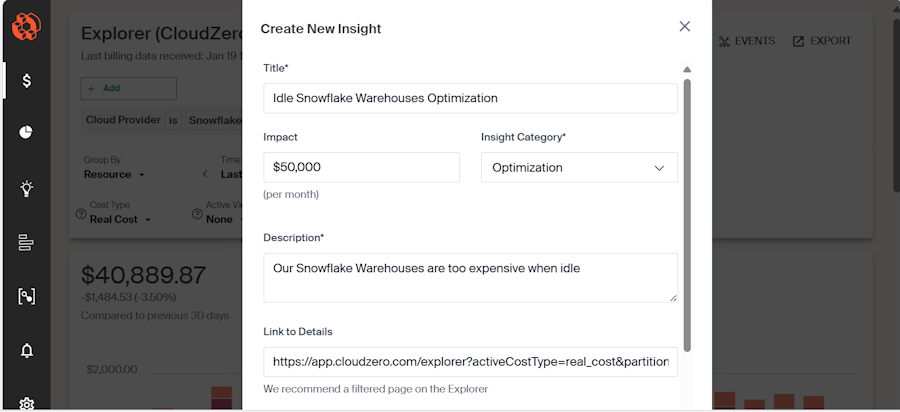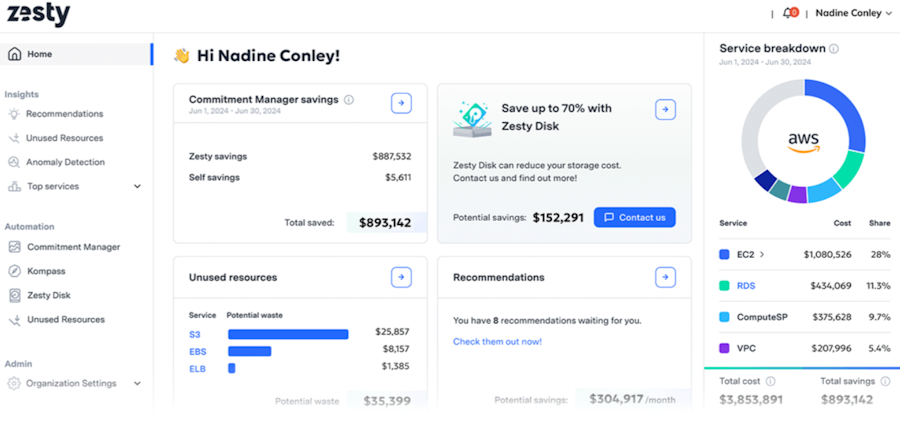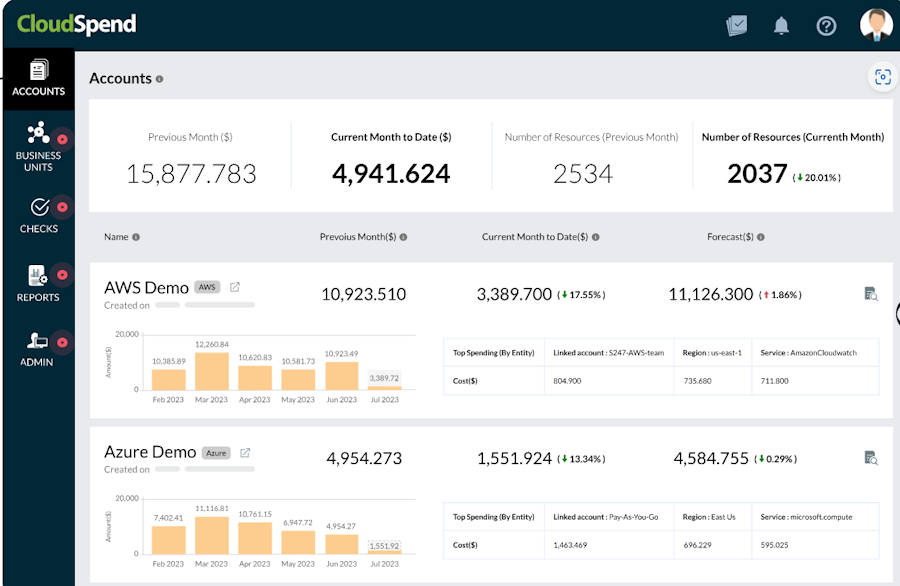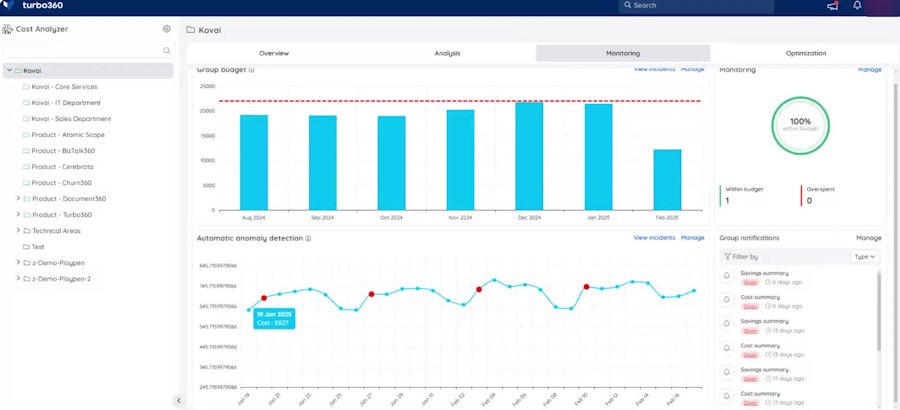Finding the right cloud cost management tool can be tricky. You have to dive deep into your organizational needs, handle feature evaluation complexity, compare various vendors, and more.
To help you make an informed decision, I’ve analyzed 27 options and selected the following top cloud cost management platforms. I reviewed their product documents, attended demos, and checked third-party reviews to verify vendor claims.
- 1. nOps
- 2. CloudZero
- 3. IBM Cloudability
- 4. Zesty
- 5. Harness
- 6. ManageEngine CloudSpend
- 7. ProsperOps
- 8. Turbo 360
- 9. Vantage
- Show less
You can trust Geekflare
At Geekflare, trust and transparency are paramount. Our team of experts, with over 185 years of combined experience in business and technology, tests and reviews software, ensuring our ratings and awards are unbiased and reliable. Learn how we test.
Cloud Cost Management Tools Comparison
For quick reference, I compared leading cloud cost management tools based on cloud provider support, optimization features, integration support, and pricing models.
Check it out below👇🏼.
| Tool Name | Cloud Provider Support | Optimization Features | Integration | Pricing |
|---|---|---|---|---|
| nOps | AWS, Azure | Resource scheduling, rightsizing, cost allocation | Jira, SSO, Datadog | On-request |
| CloudZero | AWS, Azure, GCP | Cost allocation and visibility, AI and anomaly detection, shared cost management | Databricks, MongoDB, New Relic | Percentage-based fee on $1M+ spend |
| IBM Cloudability | AWS, Azure, GCP | Recommendations on resource utilization, automated commitment program to maximize savings | Jira, Datadog, PagerDuty | On-request |
| Zesty | AWS | AI-driven automation for resource rightsizing, storage optimization, and commitment management | SSO, Salesforce, Hubspot | Usage-based with a minimal monthly base fee |
| Harness | AWS, Azure, GCP | Detecting and shutting idle resources, automating resource optimization, Intelligent EKS node autoscaling and Spot management | AppDynamics, Jira, Synk | Tiered pricing |
| CloudSpend | AWS, Azure, GCP | Right sizing, recommendations, anomaly detection, forecasting | Slack, Jira, Teams | Tiered subscription-based pricing |
| ProsperOps | AWS, Azure, GCP | Autonomous discount management, right-sizing, automated commitment management | Datadog, Slack, CloudHealth | Performance-based pricing |
| Turbo 360 | Azure | Discount insights, automatic schedules | Slack, Microsoft Teams | On-request |
| Vantage | AWS, Azure, GCP, Oracle | Cost reporting, Autopilot for saving plans, cost recommendations | Datadog, Fastly, New Relic, GitHub | Tiered subscription model |
1. nOps
nOps is an Amazon Web Services (AWS) cost optimization platform that offers various useful features, such as commitment management, cost allocation, reports and budgets, ideal resource optimization, and more.
Its AI and ML-based cost optimization process helps you control spending and optimize resources without any manual effort. As a result, you can automatically identify cost-saving opportunities. nOps allows you to filter spending by customer, product, cost center, or any category you choose.
It optimizes your environment for Spot Instances, Reserve Instances (RI), and Saving Plans to help you lower Elastic Kubernetes Service (EKS) and Auto Scaling Group (ASG) costs.
nOps Features
- Business contexts offer visibility into all your AWS costs.
- Essentials automates cost optimization tasks.
- Compute Copilot automatically manages, scales, and optimizes your AWS compute to reduce costs.
- Commitment management automatically optimizes Reserved Instances and Saving Plans.
I like nOps because its AI constantly learns your usage patterns and automatically identifies idle resources. It turns off these unused resources to reduce your AWS bill without any manual effort on your end. This helps you avoid waste, improve efficiency, and save money consistently.
nOps Pricing
nOps didn’t publish any pricing details on its website. You need to contact the company to get a pricing quote. A free demo is available to explore its features.
2. CloudZero
CloudZero is a leading cloud cost optimization platform that identifies waste and improves unit economics by automating the collection, allocation, and analysis of infrastructure spend.
CloudZero CostFormation® helps you keep track of every dollar you spend on the cloud. It shows you how your engineering work affects costs, so you can understand where your money goes. This makes it easier to make better decisions and plan your budget more accurately.
If something looks off in your spending, CloudZero’s AI will quickly alert your engineers. They can then fix the issue before it costs you more money, which helps you avoid wasting money and stay on budget.
I’m impressed with CloudZero’s ability to help you find the right balance between performance and cost. It shows you where you can improve efficiency without increasing expenses. As a result, you can grow your business without sacrificing quality.

CloudZero Features
- Identifying abnormal spend events using hourly data to prevent overspending with AI-powered anomaly detection.
- Tracking and reporting past spending while predicting future costs to stay on budget.
- Providing 100% visibility into spend with detailed drill-down capabilities through the dashboard.
- Identifying and prioritizing cloud efficiency opportunities from engineers, FinOps managers, and CloudZero insights.
- Combining business fundamentals with automated intelligence for better cloud efficiency through analytics.
- Categorizing cloud spending by customers, products, features, and teams with CloudZero Dimensions.
CloudZero Pricing
Pricing is based on a percentage of annual cloud spend, starting at $1 million in spend. It offers a free demo and online product tour.
3. IBM Cloudability
IBM Cloudability is a leading FinOps solution that helps you track, analyze, and optimize cloud spending across all major providers.
It offers multi-cloud visibility, which allows your team to manage costs from a single platform. With its Anomaly detection features, you can easily identify unusual spending patterns to reduce waste.
Automated commitment program coverage ensures maximum savings on reserved instances and savings plans.
I particularly like IBM Cloudability because of its business mapping, which connects cloud costs to business goals. This helps teams make better decisions and increase profitability. I also appreciate how rightsizing adjusts resources to match demand, reducing unnecessary expenses.
It also supports container cost allocation, forecasting, and budgeting. As a result, your team can plan more accurately.
IBM Cloudability works with tools like Jira and Datadog, helping IT, Finance, and DevOps teams improve cloud efficiency together.
IBM Cloudability Features
- Provides multi-cloud visibility to track and manage costs across all major cloud providers in one place.
- Detects unusual spending patterns to identify and reduce cost spikes or waste.
- Automates savings plan and reserved instance coverage to maximize discounts and minimize costs.
- Links cloud spend to business goals, which helps you measure profitability and improve decision-making.
- Adjusts cloud resources to match actual demand, reducing waste and improving efficiency.
IBM Cloudability Pricing
The pricing for IBM Cloudability is available upon request. A free trial is available to explore its features.
4. Zesty
Zesty is a cloud optimization platform that helps businesses reduce costs and improve efficiency with AI-driven automation.
It offers three cost-saving solutions: Kompass for optimizing Kubernetes, Zesty Disk for managing and scaling EBS storage, and Insights for tracking cloud costs and finding savings.
It provides real-time insights and recommendations to optimize computing, storage, and container resources. Zesty automatically scales cloud resources up or down based on actual demand, reducing waste and ensuring performance.
Commitment management adjusts AWS discount commitments automatically, which helps reduce Elastic Compute Cloud (EC2) costs without financial risk.
Its anomaly detection alerts teams to cost spikes before they escalate. HiberScale technology reduces node headroom and automates spot instance usage for Kubernetes.
I’m impressed with Zesty for its ability to optimize storage. Zesty Disk automatically adjusts storage volumes based on real-time needs, which can help you save up to 70% on storage costs. I also liked its prescriptive insights that give clear recommendations for high-impact actions. Consequently, it makes decision-making easier and more effective.
Zesty also minimizes engineering effort by automating resource management. This helps your teams to focus on strategic work.

Zesty Features
- Uses machine learning to unlock savings that manual processes can’t achieve.
- Automatically manages AWS discount commitments to reduce EC2 costs.
- Automatically scales cloud resources up or down based on real-time business needs.
- Identifies and alerts teams to cost spikes in real time.
- Provides prescriptive insights with actionable recommendations to optimize cloud costs.
Zesty Pricing
Zesty uses a pay-as-you-save model, charging based on the savings it generates. Kompass costs $500/month plus $5 per managed vCPU.
Zesty Disk pricing starts at $0.025/unit and decreases with higher usage.
Insights provides cost breakdowns and savings recommendations for a flat monthly fee (free for Kompass customers).
You can request a demo to explore the platform.
5. Harness
Harness is an AI-native software delivery platform that helps your engineering team modernize DevOps, measure & improve developer experience, securely deliver software, and optimize your cloud spend.
Harness Cloud Cost Management manages costs across AWS, Azure, GCP, and Kubernetes from a single platform. The Commitment Orchestrator automates long-term commitment management, which helps you maximize AWS EC2 savings.
The Cluster Orchestrator intelligently scales EKS nodes and manages Spot Instances to reduce costs and maintain performance.
The platform provides detailed cost attribution with Cost Perspectives, letting your team track and allocate expenses by teams, workloads, and applications.
I liked its Cloud AutoStopping feature that detects and shuts down idle resources. As a result, you can cut non-production costs by up to 70%.
Harness also includes Governance-as-Code with AI-powered YAML templates, enabling automated compliance and policy enforcement.
Harness Cloud Cost Management Features
- Automates compliance and remediation using Governance-as-Code (GaC).
- Maximizes AWS Elastic Compute Cloud (EC2) commitment savings by automating long-term commitment management.
- Provides intelligent autoscaling for Elastic Kubernetes Service (EKS) nodes and manages Spot Instances.
- Detects and shuts down idle resources, saving up to 70% on cloud costs.
- Identifies and alerts on cost spikes to prevent unexpected expenses.
Harness Pricing
Harness offers three pricing tiers. Free for small teams, Essentials for growing businesses with support, and Enterprise for large-scale organizations with advanced features. You can contact the sales team to explore the platform.
6. ManageEngine CloudSpend
ManageEngine CloudSpend provides clear insights into cloud costs, helping you make smarter decisions and save money. It gives full visibility into your resource inventory, allowing you to audit and manage cost-impacting elements effectively.
The platform simplifies cloud financial data with easy-to-use cost reporting, so you can easily understand spending patterns.
I like CloudSpend because the detailed usage reports help you understand your infrastructure better and identify cost-saving opportunities. The actionable insights make it easy to spot areas for improvement. Automated recommendations simplify controlling spending and reducing waste without manual effort.
CloudSpend also allows you to organize costs into cost centers, providing real-time insights and automated optimizations. You can integrate it with Site24x7 to monitor cloud costs alongside other key metrics.

CloudSpend Features
- Streamlining Kubernetes costs by cutting over-provisioning and paying only for what you use.
- AI-driven monitoring automatically identifies unexpected cost spikes and sends real-time alerts.
- Detecting idle resources in non-production environments and triggering automated actions to reduce waste.
- Virtual tagging solution enhances visibility and control over cloud resources across the organization.
- Tracking cloud discounts, monitoring changes in coverage, and discovering savings opportunities.
CloudSpend Pricing
ManageEngine CloudSpend offers a free service for cloud bills up to $3,000/month. Bills above $3,000 cost 1% monthly. A 30-day free trial is available.
7. ProsperOps
ProsperOps automates cloud cost optimization across AWS, Azure, and Google Cloud, helping businesses reduce spending with minimal effort.
It continuously adjusts commitments based on usage changes, which increases the Effective Savings Rate (ESR) and maximizes savings.
ProsperOps automates thousands of monthly actions to improve commitment utilization and generate consistent savings.
ProsperOps offloads commitment management, allowing FinOps teams to focus on strategic priorities. Moreover, it automates repetitive rate optimization tasks, saving your teams tons of time.
I like ProsperOps because it lets organizations visualize savings potential clearly, so they can see how much they’re saving and where they can improve. The ability to benchmark performance vs. peers helps companies understand how their savings rate compares to others in the industry.
ProsperOps Features
- Continuous cloud cost optimization across AWS, Azure, and Google Cloud with zero effort.
- Intelligent Showback for automated reallocation of commitment costs and savings.
- Automated commitment management to maximize flexibility and reduce waste.
- Insight-driven reporting with core KPIs and team-level allocation details.
- Net Savings Trend graph to track savings outcomes and ESR over time.
ProsperOps Pricing
ProsperOps charges a small percentage of the savings it generates. Get a free cloud savings analysis with no commitment. Only pay if you save money.
8. Turbo 360
Turbo 360 is a cloud management platform for Microsoft Azure. It optimizes costs, monitors cloud resources, and creates technical documentation from a single platform.
You can gain detailed cost visibility by organizing expenses in a structured way across different business dimensions. This means tracking costs by departments and cost center owners, making it easier to see who is spending what.
You can also identify and handle unusual spending quickly. The system detects cost anomalies — unexpected or out-of-pattern expenses — and directs you to the exact infrastructure resource causing the issue. Consequently, you can fix problems faster and prevent waste or budget overruns.
I chose Turbo 360 because it helps quickly create detailed technical documents about Azure usage, cost, security, and compliance. You can save time with autogenerated editable diagrams that clearly show how your Azure resources are organized based on your application architecture, which makes auditing and managing Azure much easier and faster.

Turbo 360 Features
- Allocates 100% of Azure resource costs across departments and business units.
- Identifies and resolves unexpected Azure cost spikes to stay on budget.
- Uses historical data to make informed decisions on Azure Reservations for discounts.
- Continuously optimizes costs with rightsizing recommendations for over-provisioned or unused resources.
- Provides consistent cost data to align stakeholders on business-relevant metrics and budget decisions.
Turbo 360 Pricing
Pricing includes a free 15-day trial. Annual commercial plans provide full product access for cost optimization and monitoring.
9. Vantage
Vantage makes cloud cost management simple and effective. It offers detailed cost reports to track spending and identify trends easily. The resource reports show which services drive costs, which helps you manage cloud expenses better.
You can create custom cost allocation tags to organize spending across different providers. Cost allocation segments let you enforce cost governance and track expenses within your organization.
Vantage provides usage-based reporting, giving clear insights into how your cloud resources are being used. Its savings planner helps you model and forecast future savings. So, you can plan better. With unit costs, you can see spending at a granular level — per customer, per query, or per endpoint.
I liked its automated anomaly detection feature, which alerts you to unusual costs before they become problems. You can track issues and assign them to team members, keeping communication organized.
Vantage also integrates with Jira to track issues easily and collaborate with teams.
Vantage Features
- Automates buying of AWS Savings Plans and provides savings recommendations for RDS, ElastiCache, Redshift, and OpenSearch.
- Identifies the main drivers of network costs for better visibility and control.
- Tracks key FinOps metrics like effective savings rate, coverage, and total discounts.
- Pinpoints individual resource costs to eliminate guesswork.
- Enables FinOps as Code for automated cloud cost management using Terraform.
Vantage Pricing
Turbo 360 offers four plans:
- Starter (free) for up to $2,500 in costs
- Pro ($30/month) for up to $7,500
- Business ($200/month) for up to $20,000
- Enterprise offers custom pricing for costs over $20,000
Both Pro and Business plans offer a 14-day free trial.
More Cloud Cost Management Tools
I have also explored the following cloud cost management tools and found them worth mentioning.
| Cloud Cost Management Tool | Key Features | Pricing |
|---|---|---|
| 10. Flexera | Automated cost allocation, complete cloud spend visibility, multi-cloud optimization insights | On-request |
| 11. Spot | Dynamic cost and usage visualizations, actionable insights for quick savings, customizable dashboards | On-request |
| 12. Densify | AI-driven workload instance optimization, detailed impact analysis and reporting | On-request |
| 13. Cast AI | Automated Kubernetes cost optimization, cluster autoscaler, spot Instance automation | $200/month + $5/CPU |
| 14. CloudOptimo | AI-driven resource and cost optimization, Smart autoscaling and scheduling, compliance tracking | $25/month |
| 15. Finout | Codeless waste detection and reduction, spend allocation, and waste prioritization | $1k/month |
| 16. CloudForecast | Daily and monthly cost reporting, tagging compliance, and waste tracking | $99/month |
| 17. Astuto | Real-time cost leak detection, AI-driven actionable insights, centralized tracking, and task management | $49/month |
Why Is Cloud Cost Management (CCM) Essential?
In recent years, many companies have been shifting their businesses and operations to cloud infrastructure for benefits like cost savings, scalability, higher performance, centralization, business continuity, and security. So it is no surprise that the global cloud computing market is expected to reach USD 1,554.94 billion by 2030.
However, cloud computing benefits come with challenges, especially the rising cloud costs.
Cloud spending is increasing, and failing to manage costs can lead to financial strain. Poor cost management may result in unexpected expenses, overpaying for underused resources, or even performance issues.
According to CloudZero research, 49% of organizations say their cloud costs are higher than expected, and only 3 out of 10 organizations know exactly where their cloud spend is going.
Cloud cost management (CCM) is a strategy businesses need to optimize cloud infrastructure and control costs. It involves maximizing cloud usage and increasing efficiency to reduce overall infrastructure expenses.
A clear cost management strategy can improve forecasting, boost profits, and increase accountability across the organization by providing better visibility into cloud expenses and usage.
5 Benefits of Cloud Cost Management
The adoption of cloud computing is increasing rapidly across various sectors due to its scalability, flexibility, and cost-effectiveness.
However, the benefits of the cloud come with new challenges, especially in cost management. This is where cloud cost management (CCM) tools come into play.
Here are some key benefits of adopting cloud cost management tools:
- CCM allows businesses to estimate and control costs accurately, helping to optimize cloud spending and reduce waste.
- CCM solutions provide visibility into consumption and expenditures, which enables companies to manage cloud resources and budgets efficiently.
- Cloud cost management tools generate cost-saving insights by identifying underutilized resources and opportunities to leverage more cost-effective cloud services.
- CCM helps businesses make informed decisions about cloud usage by maximizing resource utilization and providing detailed cost analysis.
- Businesses can use CCM to identify cost-cutting opportunities, avoid unexpected expenses, and ultimately save money.
In short, CCM tools help forecast cloud usage, plan for scalability, improve performance, ensure compliance, strengthen security, and achieve significant cost savings.
How To Pick the Best Cloud Cost Management Tool?
A few characteristics of cloud cost management solutions that would simplify the process include the following:
- Automation and an AI-driven platform
- Identify idle and underutilized cloud resources
- Predict cloud usage at granular levels
- Right-size the services
- Comprehensive reporting
- Visibility and in-depth spending analysis
- Use reserved instances and leverage spot instances
- Monitor cost anomalies
- Use appropriate storage options
- Provide cost analysis at each stage of the SDLC
- Identify and minimize software license costs
- Notifications for breaching cost thresholds
- Create and manage multiple cost budgets
- Alerts for exceeding resource utilization
The features mentioned above will help you choose the right cost management tool for your cloud environment.
Pick the Right Cloud Cost Management Tool
Now you know the leading cloud cost management platforms, their features, and how to choose the best solution.
I recommend taking multiple trials and product demos of the listed tools to find the right cloud cost management solution that meets your organizational requirements.
Explore more on Cloud Management
-
 EditorRashmi Sharma is an editor at Geekflare. She is passionate about researching business resources and has an interest in data analysis.
EditorRashmi Sharma is an editor at Geekflare. She is passionate about researching business resources and has an interest in data analysis.


